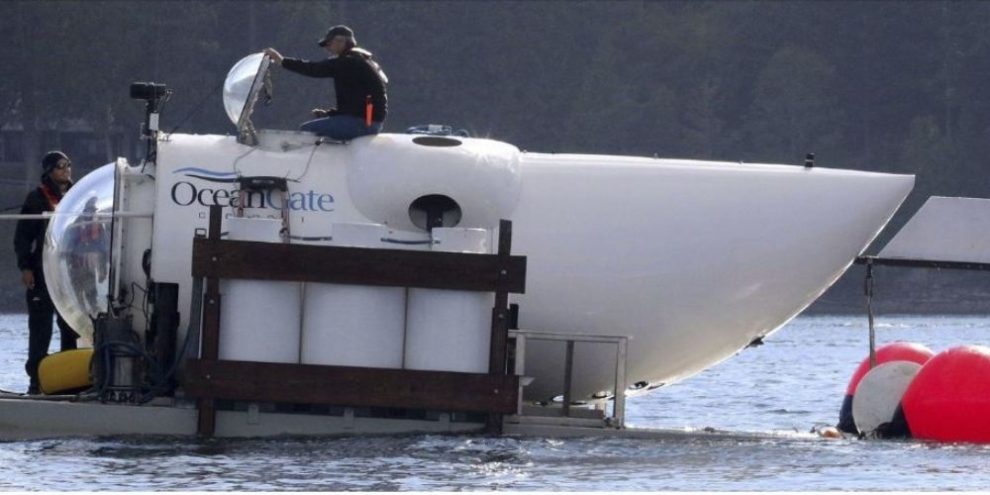
By Michael MacDonald
A catastrophic implosion ripped apart the Titan submersible, killing all five people aboard as it was descending to the bottom of the North Atlantic during an expedition to the wreck of the Titanic, a U.S. Coast Guard official said Thursday.
Several pieces of the minivan-size craft, including parts of its carbon-fibre hull, were found in a debris field on an otherwise clear section of the ocean floor, about 500 metres from the bow of the sunken luxury liner, Rear Admiral John Mauger, commander of First Coast Guard District in Boston, told reporters.
"The debris is consistent with the catastrophic loss of the pressure chamber," Mauger said at a briefing in Boston. "Upon this determination, we immediately notified the families."
Those killed include the vessel's pilot, OceanGate Expeditions CEO Stockton Rush, British billionaire Hamish Harding, French explorer and Titanic expert Paul-Henry Nargeolet and Pakistani businessman Shahzada Dawood and his 19-year-old son, Suleman.
"On behalf of the United States Coast Guard … I offer my deepest condolences to the families," Mauger said. "I can only imagine what this has been like for them, and I hope that this discovery provides some solace during this difficult time."
OceanGate Inc. issued a statement saying the men who died were "true explorers who shared a distinct spirit of adventure."
"Our hearts are with these five souls and every member of their families during this tragic time," said company spokesman Andrew Von Kerens. "We grieve the loss of life and joy they brought to everyone they knew."
The bleak discovery of Titan's distinctive tail cone and other parts were made Thursday morning by a crew guiding a remotely operated vehicle (ROV) that was launched from the MV Horizon Arctic, a large Canadian tug and supply ship.
The Titan submersible, operated by Rush's U.S.-based company, lost contact with surface vessels on Sunday morning as it was nearing the Titanic wreckage during a 3,800-metre dive that typically takes about two hours to complete. The remote site is about 700 kilometres southeast of eastern Newfoundland.
It remains unclear exactly what happened to Titan, but coast guard experts said the expanse of its debris field indicated that it came apart in the water column above the doomed steamship, which sank on April 15, 1912.
In all, five large pieces of the submersible were spotted. A coast guard expert said their location was consistent with where the vessel was expected to be when it lost contact with surface ships on Sunday morning.
As well, Mauger confirmed that the implosion did not happen while the search operation was underway because aircraft dropping sonar-equipped buoys would have recorded that sound.
"We had listening devices in the water throughout and did not hear any signs of catastrophic failure," he said, adding that the ROVs on the ocean floor would continue to gather evidence of what happened.
When asked if there was any possibility of recovering the victims' bodies, Mauger said: "This is an incredibly unforgiving environment down there on the sea floor .... We'll continue to work and search the area, but I don't have an answer at this time."
On Wednesday, the U.S. Coast Guard, which led the search for the privately owned Titan, confirmed that sonobuoys dropped in the ocean by a Royal Canadian Air Force CP-140 Aurora patrol aircraft had picked up "banging sounds" earlier that day and on Tuesday, but Mauger said those unidentified noises had no connection to the grim finds on Thursday.
Some experts had suggested the noises could have come from sea creatures or from other vessels in the area.
There was speculation that the massive search effort, which included five vessels on Thursday, had reached a critical stage that day because OceanGate had said Titan's 96-hour air supply could be running low. But that warning assumed the submersible was still intact.
Jamie Pringle, a professor in forensic geosciences at Keele University, in the United Kingdom, said the first 24 hours are the "golden hours" for a below-surface search, and after that the chances for success decline sharply.
"That's when most people are found in water searches, and after that time chances of survival reduce massively," he said in an interview Thursday, citing low temperatures, declining oxygen and rising levels of fatigue.
Paul Johnston, curator of maritime history at the Smithsonian, in Washington, D.C., said OceanGate's brand of "frontier tourism" is a risky business. Asked about the debris field discovery, Johnston said the find raises questions about making the Titanic off limits to tourists.
"I believe that the current accident will probably diminish interest in Titanic tourism and maybe ‘risk tourism’ in general," he said in an interview Thursday. He rejected the notion that these undersea tours are a form of exploration.
"(These are) people who are going down to look at an underwater graveyard," he said. "Who cares how much iron there is in the water column around the ship, or how quickly the rusticles (on the Titanic) grow. To me, that’s of no scientific interest whatsoever .... I think it’s a plaything for wealthy people — a checkbox on a bucket list.”
Meanwhile, some marine engineering experts have come forward to raise concerns about Titan, which was never "classed" or certified by an independent third party to ensure it met certain safety standards.
William Kohnen, president and CEO of the California-based engineering firm Hydrospace Group, has said about 95 per cent of all submersibles are certified. Titan, he said, "is very much an outlier."
Kohnen was part of a group of engineers and industry professionals who wrote to Rush in 2018 to express their concern. Their letter, first obtained by the New York Times, warned that the company’s “experimental” approach to Titan could have “catastrophic” consequences.
In a 2019 blog post, OceanGate explained that Titan — made from carbon fibre and titanium — was not classed because the process could inhibit innovation and did not address pilot error, which it said is the cause of most marine accidents.
In previous interviews, Rush showed off Titan's many off-the-shelf features, including a steering control made from a video game controller, and cabin lights purchased from a camping store.
This report by The Canadian Press was first published June 22, 2023.
— With files from Sarah Smellie in St. John's, Michael Tutton in Halifax, and The Associated Press.
Banner image: OceanGate CEO Stockton Rush emerges from the hatch atop the OceanGate submarine Cyclops 1 in the San Juan Islands, Wash., on Sept. 12, 2018. THE CANADIAN PRESS/AP-Alan Berner/The Seattle Times via AP





